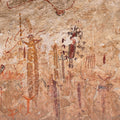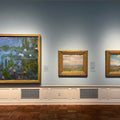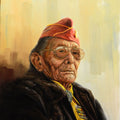Tony Abeyta honored as first Native American to receive U.S. Medal of Arts award
By Medicine Man Gallery on
Tony Abeyta, 2021 (cropped)| Photo by Larry Price
On September 13, 2023, in a ceremony presided over by First Lady Dr. Jill Biden at the White House, Tony Abeyta (b. 1965, Gallup, New Mexico; Diné (Navajo)) became the first Native American honored as a U.S. Department of State Medal of Arts recipient. The Medal of Arts award was created by Art in Embassies, in partnership with the Secretary of State, in 2012 to formally acknowledge artists who have played an exemplary role in advancing the Department of State’s mission to promote cultural diplomacy.
What has become the Art in Embassies program was first envisioned by the Museum of Modern Art in 1953 as a means of transporting American ideals to the rest of the world by distributing and displaying contemporary art in American embassies and deploying artists as cultural envoys to local communities. President John F. Kennedy formalized it at the U.S. Department of State in 1963.
Abeyta’s artwork has been featured in numerous Art in Embassies exhibitions, and his lithograph Infinite Wisdom (2015) was created as part of a collaboration between Art in Embassies and the Institute of American Indian Arts to highlight the diversity and vitality of Native American contemporary art. Infinite Wisdom is included in the permanent art collections of the U.S. embassies in Ankara, Türkiye; Oslo, Norway; and Niamey, Niger.
Abeyta was not aware he was in the running for the award – he was not aware there was such an award – prior to his receiving a phone call informing him he had been chosen. After initially being told to keep the selection hush-hush, a subsequent phone call informed him not to say anything about the honor or forthcoming ceremony because it would be held at the White House.
“This is a bigger deal than I thought,” Abeyta said, the gravity of the honor finally hitting him. “It's one of those things, like, ‘is this real?’ I of course didn't realize the other awardees of the past and (when I researched it) I saw there was some real heavy hitting, mainstream, amazing people.”
Abeyta joins past inductees including Jeff Koons (2013), Sam Gilliam (2015), Maya Lin (2015), Jenny Holzer (2017), Mark Bradford (2015) and Kehinde Wiley (2015). His fellow Medal of Arts inductee classmates includes Hank Willis Thomas, one of the most eminent contemporary artists of the past 25 years, an artist whose international esteem would be difficult to overestimate.
“Art is about connection. Art is the evidence and expression of our humanity and even when it’s easy to get caught up in differences, art can unite us,” Biden said at the ceremony. “Connection is what diplomacy is all about.”
Abeyta, who was accompanied to the event by his daughter and girlfriend, took pictures with Biden, or more accurately stated, had pictures taken with Biden. All of the artists’ cellphones were confiscated by security beforehand.

Tony Abeyta, Untitled, 2012. The James Museum of Western and Wildlife Art | Photo by Chadd Scott
One Stands for Many
Abeyta is no stranger to prestigious recognition. As a past recipient of the New Mexico Governor’s Excellence in the Arts award, an Honorary Doctorate in the arts from The Institute of American Indian Arts, and selection as a Native Treasure by the Museum of Indian Arts & Culture in Santa Fe, he knows what it’s like to stand in the spotlight. He also knows he doesn’t stand there alone.
“It's really not an award for me and my accomplishments – somewhere in there I had something to do with it – but it really is remarking on all those people who came before me, influenced me, supported my ideas and vision and creativity – communities, educational institutions, everything and everybody that has been part of it,” Abeyta said.
Prominently, that includes his family, artists themselves. His late sisters, Pablita and Elizabeth, and his late father, Narciso, were all featured in an exhibition, “Abeyta: To’Hajiilee K’é,” at the Wheelwright Museum of the American Indian in 2022-23.
Learning he was the first Native American artist to claim a Medal of Arts award added another layer of significance.
“Acknowledging Tony Abeyta doesn't mean a lot, but it's another step towards the acknowledgement of Indigenous people and (correcting) the marginalization of Native peoples and their accomplishments in American art and culture,” Abeyta said.
Never has that correction been more dramatic than in 2023.
Earlier this year, a retrospective exhibition for Jaune Quick-to-See Smith (b. 1940; citizen of the Confederated Salish and Kootenai Nation) opened at the Whitney Museum of American Art in New York, the most prestigious institution devoted to artmaking from this country. It was the first such presentation for a Native American artist in its almost 100-year history. Smith scores another first this fall when she becomes the first artist to curate an exhibition at the National Gallery of Art in Washington, D.C., that esteemed institution’s first presentation of contemporary Native art in 70 years. This summer, Jeffrey Gibson (b. 1972; Mississippi Band of Choctaw Indians and of Cherokee descent) was tabbed to represent the U.S. at the 2024 Venice Biennale, a first in the event’s 129-year history.

Tony Abeyta, Moving Camp to the North | Photo by Chadd Scott
Echoes of History
Prominent Native Americans being invited to Washington for receipt of medals from the government calls to mind the 18th and 19th century when that practice was patronizingly carried out with Indigenous leaders from across the continent. Upon signing a peace treaty, the president would present a Peace Medal.
The parallels with his recognition are not lost on Abeyta.
“A medal represents different things tied to treaties, tied to negotiations between Native Americans and our U.S. government that often weren't honored,” Abeyta said. “I think the difference in this case is it's about honoring the art and creativity of individual artists and those accomplishments aren't something that can be revoked. It's more about the acknowledgement and representation of what we've done in the past and the communities that we emerge from.”
Ironically, the day before Abeyta was honored at the White House, 30 activists, mostly Native Americans, were arrested outside the building during a protest advocating for Leonard Peltier’s release from federal prison. Peltier, 79, Turtle Mountain Band of Chippewa citizen from North Dakota, has been incarcerated for 48 years following his conviction on two first-degree murder charges of FBI officers during a shootout on the Pine Ridge Reservation in 1975.
The evidence against Peltier and his trial were dubious, to say the least, and Native rights and human rights organizations around the world have been seeking amnesty for the former American Indian Movement leader ever since. Abeyta has been involved in the movement to free Peltier since the late 1980s, helping with fundraising campaigns for his ongoing legal expenses.
“It's a difficult thing to want to be in two places, inside and outside, and realize it can be a conflict of interest, so I kept the focus on why I was there… these are things that I take into consideration and it's really hard to have all of those hats on simultaneously,” Abeyta admits of his time at the White House, its residents’ historic abuses of Native people, and the honor he was receiving there.
Speaking to the Universal
Art serves as a bridge with other nations, encourages discussion and expression, and highlights the communal experience of people from countries, cultures, and backgrounds worldwide.
The selection of these artists and their work by the nation for display overseas signals they represent the best of us, how America would like to be seen internationally. They symbolize American ideals, ideals often not carried out in practice.
“Art is a vehicle that we all understand is vital to the human experience and some of the things that we have in common – our beliefs, our values – all these things together form a better understanding of who we are as humans,” Abeyta said. “I'm an artist and so I have that voice and that singles me out. I have this agency to create and say what I want to say… and that same voice is identified in other places, in other countries. It's a global human experience to know pain, loss, love, beauty, nature, angst, and rebellion, all of those things that are common human narratives.”

Tony Abeyta (Dine), Stormy Canyon. La Fonda Hotel | Photo by Chadd Scott




